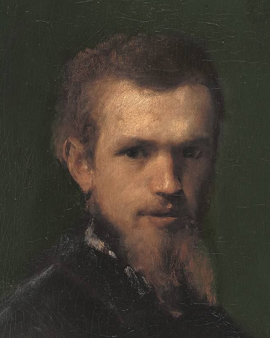The Bavarian painter Franz Lenbach is also called "the Munich painter prince" by art historians. This name is no accident, as Lenbach's lifestyle was upscale and luxurious. Franz Lenbach, who came from a family of bricklayers with many children, was even knighted in 1882 and thus rose to the ranks of the nobility. The up-and-coming upper middle classes and nobility wanted to have him painted and offered large sums of money for his portraits.
As for many artists of his time, a trip to Italy was formative for his further style. Since Goethe, German artists in the 18th and 19th centuries have travelled in the footsteps of ancient cultures to the land of longing, Italy. There they hoped to find inspiration at the sites of Roman civilization and amid the art and architecture of the Italian Renaissance. As a young man he visited Rome and Florence and trained his art on the works of the old masters. He made copies of important works such as Tizians and Rubens.
Lenbach's style was also clearly influenced by his teachers at the Academy of Fine Arts in Munich. The painter Carl Theodor von Piloty brought the young and promising artist Lenbach back from Italy to the Academy in Munich. There, under Piloty's watchful eye, Lenbach developed his special style, which focused on atmospheric coloring and lifelike staging. Lenbach's style was innovative in the sense that he focused his attention on the presentation of the individuality of his models. Lenbach wanted to depict his models with dignity and, despite all naturalism, to avoid depictions of poverty or misery, as could be found in Gustave Courbet or Jean Francois Millet, for example. Instead, Lenbach found his artistic role models more in the old masters such as Titian or Peter Paul Rubens.
With the success of his art, Franz Lenbach succeeded in making himself a wealthy and influential artist. He portrayed celebrities such as Otto von Bismark and even the acting pope. Nevertheless, he did not forget his family. He gave financial support to his siblings throughout his life. Lenbach's style suited the increasingly influential bourgeoisie of his time very well. Rich citizens wanted to be portrayed just as dignified and skilfully as the nobility. Lenbach was the right address for them.
Even though Franz von Lenbach was able to win the recognition of his contemporaries, his love life looked rather bad. During the first half of his life Lenbach was unhappily in love with Countess Marie von Dönhoff, who was trapped in an equally unhappy marriage with a Prussian diplomat. After her divorce, however, she chose not Lenbach but Bernhard von Bülow, the later Chancellor of the Reich, as the new man at her side. Lenbach's portrait of the Countess is still one of his most famous paintings. Even his two late marriages could not help him over this loss.
×





.jpg)
.jpg)
.jpg)
.jpg)
.jpg)
.jpg)
.jpg)
.jpg)
.jpg)
.jpg)
.jpg)
.jpg)
.jpg)
.jpg)
.jpg)
.jpg)
.jpg)
.jpg)
.jpg)
.jpg)
.jpg)
.jpg)
.jpg)
.jpg)
.jpg)
.jpg)
.jpg)
.jpg)
.jpg)
.jpg)
.jpg)
.jpg)
_-_(MeisterDrucke-1343502).jpg)
_-_(MeisterDrucke-1343502).jpg)
.jpg)
.jpg)
.jpg)
.jpg)
_Freifrau_von_Plessen-Cronstern_-_(MeisterDrucke-1343860).jpg)
_Freifrau_von_Plessen-Cronstern_-_(MeisterDrucke-1343860).jpg)
.jpg)
.jpg)
_-_(MeisterDrucke-1343360).jpg)
_-_(MeisterDrucke-1343360).jpg)
.jpg)
.jpg)
.jpg)
.jpg)
.jpg)
.jpg)
.jpg)
.jpg)
.jpg)
.jpg)
.jpg)
.jpg)
.jpg)
.jpg)
.jpg)
.jpg)
.jpg)
.jpg)
.jpg)
.jpg)
.jpg)
.jpg)
.jpg)
.jpg)
.jpg)
.jpg)
.jpg)
.jpg)
_mit_weiblicher_Gestalt_-_(MeisterDrucke-1343111).jpg)
_mit_weiblicher_Gestalt_-_(MeisterDrucke-1343111).jpg)
.jpg)
.jpg)
_-_(MeisterDrucke-1342694).jpg)
_-_(MeisterDrucke-1342694).jpg)
.jpg)
.jpg)
.jpg)
.jpg)
.jpg)
.jpg)
.jpg)
.jpg)
.jpg)
.jpg)
.jpg)
.jpg)
.jpg)
.jpg)
.jpg)
.jpg)
.jpg)
.jpg)
.jpg)
.jpg)
.jpg)
.jpg)
.jpg)
.jpg)
.jpg)
.jpg)
.jpg)
.jpg)
.jpg)
.jpg)
.jpg)
.jpg)
.jpg)
.jpg)
.jpg)
.jpg)
.jpg)
.jpg)
_-_(MeisterDrucke-1343588).jpg)
_-_(MeisterDrucke-1343588).jpg)
.jpg)
.jpg)
.jpg)
.jpg)
_1871_-_(MeisterDrucke-805114).jpg)
_1871_-_(MeisterDrucke-805114).jpg)
.jpg)
.jpg)
.jpg)
.jpg)
.jpg)
.jpg)
.jpg)
.jpg)
.jpg)
.jpg)
.jpg)
.jpg)
.jpg)
.jpg)
.jpg)
.jpg)
.jpg)
.jpg)
.jpg)
.jpg)
.jpg)
.jpg)
.jpg)
.jpg)
.jpg)
.jpg)
.jpg)
.jpg)
.jpg)
.jpg)
.jpg)
.jpg)
.jpg)
.jpg)
.jpg)
.jpg)
.jpg)
.jpg)
.jpg)
.jpg)
.jpg)
.jpg)
.jpg)
.jpg)
.jpg)
.jpg)
.jpg)
.jpg)
.jpg)
.jpg)
.jpg)
.jpg)
.jpg)
.jpg)
.jpg)
.jpg)
.jpg)
.jpg)
.jpg)
.jpg)
_Graefin_Erduedy_-_(MeisterDrucke-1343336).jpg)
_Graefin_Erduedy_-_(MeisterDrucke-1343336).jpg)
.jpg)
.jpg)
.jpg)
.jpg)
.jpg)
.jpg)
_-_(MeisterDrucke-1342708).jpg)
_-_(MeisterDrucke-1342708).jpg)
.jpg)
.jpg)
.jpg)
.jpg)
.jpg)
.jpg)




